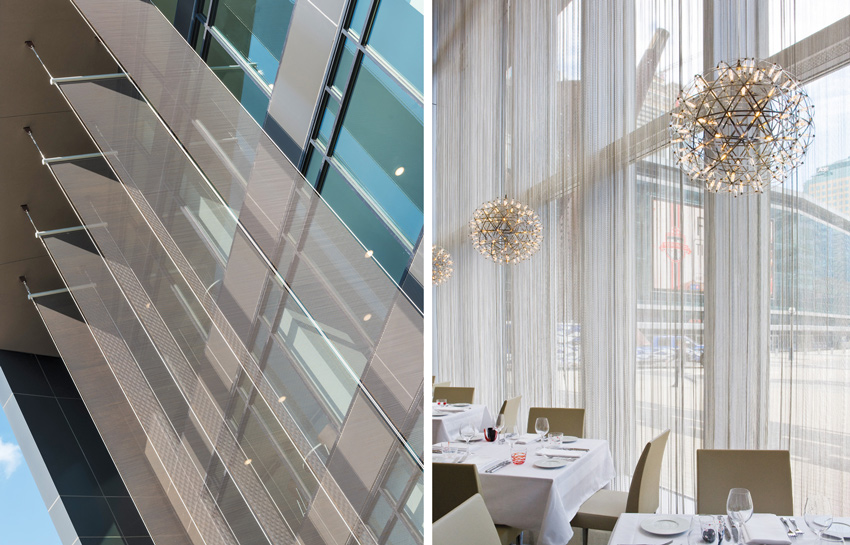Resilient Design
Glass and Glazing Systems
For buildings to be resilient enough to survive severe weather and still be functional after an event, the most vulnerable parts of the building must be addressed. This means looking at the entire building envelope, including the roof, walls, and, most notably, glass and glazing systems. The typical approach is seen in news reports of people putting up plywood over windows as a storm approaches. That may work for residential and low-rise commercial buildings, but it is not practical for anything higher than two stories. Furthermore, typical exterior building materials for commercial and institutional buildings are normally not conducive to having plywood nailed or screwed onto them.

Photo courtesy of C.R. Laurence Co., Inc.
High-performance entrance systems provide greater resilience through properly specified components and enhanced thermal properties, all while offering an elegant design using ultra-narrow door stiles.
What is the best approach for most buildings then? To design them with glass and glazing systems that incorporate materials and products that are intentionally fabricated and tested to withstand severe weather conditions, such as high wind loads, airborne debris impact, and/or extreme temperatures. These products can significantly improve the resiliency of buildings. They can also take a variety of forms with some of the more common types discussed in the following sections.
Thermal Entrance Systems
Many commercial, institutional, and industrial buildings incorporate aluminum-framed storefront and glass entrance systems on the first floor. While these are fairly common, there are real differences in the way these types of storefront and entrance products perform. In the case of resiliency, attention should be placed on the specification of the component parts and materials.
A resilient entrance system means that it is strong enough to withstand serious damage from storms while providing superior thermal performance. That way, if the building is occupied, it will help keep the interior environment warm in cold weather and cool in hot weather—a notable benefit at any time, but especially if the building is without power for extended periods.
Achieving this higher level of performance is based fundamentally on three things: the structural and material integrity of the aluminum frame and glass; the insulating value of the system; and the ability to prevent air and water infiltration through the system. Fortunately, there are products available that address all three of these criteria and manage to do so with aesthetic qualities that are appealing and sought after. For example, there are ultra-narrow stile entrance systems available that provide an elegant, all-glass appearance while still delivering exceptional thermal performance normally found in full-frame doors. Excellent thermal performance translates to U-factors as low as 0.33 to help control heat transfer during extreme temperature conditions. This is achieved in part by allowing insulating glass to be used that is 1 inch thick. In addition, such entrance systems meet or exceed the air infiltration requirements of the International Energy Conservation Code (IECC) and ASHRAE 90.1, both of which contain mandatory provisions on this topic.
As a premium storefront product, these entrance systems retain a desirable appearance of heavy glass doors with minimal vertical lines. When it comes to the hardware used for door pulls and panic devices, it is possible to attach them directly to the glass. At least one manufacturer has developed a means to secure such door-pull hardware directly onto 1-inch insulating glass panels using unique through-glass fittings. This provides an added aesthetic and functional benefit without compromising the performance of the doors.
Protecting People and Property
Resilient building design needs to address a variety of potential forces or conditions that can harm people or damage buildings. As already noted, these can include protection from wind-borne debris/missiles but can also include protection against sudden bursts of pressure or even blasts. An alternative to raising the protective performance of individual building envelope components, such as glass and glazing systems, is to protect them with an additional material that is placed on one side or the other. This creative solution is based on using conventional, proven materials in innovative ways.
What type of material would be appropriate here? One choice is coiled wire fabric, which acts like a metal curtain or screening to cover and protect walls, glazing, and entrances in a way that allows a good deal of design flexibility. Coiled wire fabric is often used to provide solar protection and ornamental decoration in buildings. By selecting a grade and type of wire fabric that is appropriately tested, protecting the critical components of a building’s envelope is also possible. Such an approach can help avoid a breach in the envelope that would allow wind and water penetration inside. This can be achieved using coiled wire fabric systems on either the inside or outside of the building enclosure.
For a better understanding of this design concept, let’s now take a closer look at this innovative product.
Coiled Wire Fabric Systems
First, it is important to recognize that coiled wire fabric products are different from traditional metal mesh materials. The essential difference is they are designed as architectural products for use as a finish material, not just a utilitarian one. As a durable, thin material, coiled wire fabric is lighter in weight than traditional wire mesh and offers more design flexibility. For interiors, architects and designers use coiled wire fabric products for window curtains, ceiling treatments, wall coverings, security gates, and even as complete sculpting partitions, all adding elegance and purpose to the spaces where they are used. On building exteriors, they can provide sun shading, fall protection, and visual facade treatments. In all cases, they can allow for ventilation or the controlled passage of air and light.

Photos courtesy of Cascade Architectural
Coiled wire fabric can be used on either the outside or the inside of buildings to provide a variety of attributes, including increased resilient design.
Notice

www.cascade-architectural.com

www.crl-arch.com









